Follow-Up to Your Questions on Knitting Injuries, Pics of Exercises and a Winner
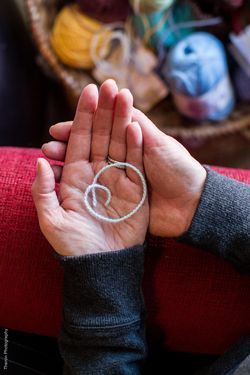 I admit it: The idea of being injured by knitting used to be a joke to me. Seriously. When people talked about such things I'd roll my eyes. Nowadays, I'm the one who is first to say that I can't roll my eyes anymore because, when I do, I get nerve pain down my right arm. Well, I'm kidding about that, but it is, for all intents and purposes (love saying that), just about true.
I admit it: The idea of being injured by knitting used to be a joke to me. Seriously. When people talked about such things I'd roll my eyes. Nowadays, I'm the one who is first to say that I can't roll my eyes anymore because, when I do, I get nerve pain down my right arm. Well, I'm kidding about that, but it is, for all intents and purposes (love saying that), just about true.
Another thing that is true is, that I think I might deserve a medal for my latest bout of epic white-knuckle knitting (Ha! another knitting joke that only we can appreciate). I can't show you the project because it'll be featured in my next book, but what I can show you is the leftover yarn. Talk about nearly having a heart attack.
Lindsay, our resident expert on knitting injuries, physical therapist and all around good gal, has read through all your comments/questions and since she's so smart, instead of just answering a few, she addressed multiple problems into a nice, neat article, just for us.
Here it is:
As a physical therapist I see many people with over-use injuries, however I had no idea how many of my fellow knitters had such symptoms! All of your comments were great, and I wish I could get to each and every one. Instead, I am going to try to address some of the trends that emerged. Absent this helping you, feel free to email me at Lindsay@sfsspt.com, and I’ll do my best to answer your question or direct you to where you can find it.
Many of you wanted to know about issues with carpal tunnel and knitting. Carpal tunnel syndrome occurs when the median nerve, which runs on the inside of your wrist, gets inflamed and irritated, typically from sustained positions of holding your wrists up (hello knitting and typing!) The best things you can do for this include trying to modify your position by keeping your wrists as relaxed as possible as well as keeping your arms close to your body. Also important is taking breaks and doing some stretching. Important to do is a wrist extension and wrist flexion stretch.
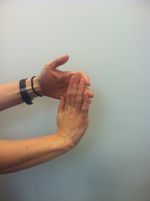

For really stiff fingers, including trigger fingers, as well as those hoping to avoid finger pain and tightness while knitting maybenefit from doing what is referred to as ‘tendon gliding.’ It is a series of movements which stretches out the tendons that run on your palm to each joint of your fingers. Follow the series 1-5 a few times when you are taking a break from knitting. Opening and closing your fist as well as spreading your fingers can also help. Many people find that heat is helpful to warm up the hand and reduce stiffness. Using a heating pad, or even wearing fingerless gloves, can keep your hands from getting cold.
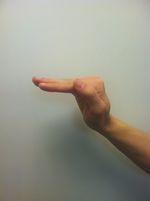

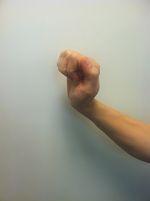
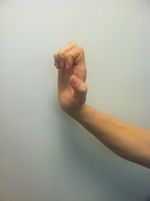
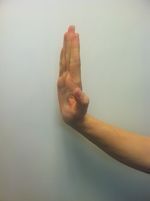
Which brings me to bracing. I prefer that my patients DON’T wear a brace while they knit. Understandably it may be the only way that you can knit without pain, but my concern would be that you are basically training yourself towards relying on a brace while knitting. If you experience popping in the fingers and wrists it isn’t typically an issue unless it is painful. A lot of time the joints are releasing built up pressure from the sustained positions they are in.
The other thing that a lot of people commented on was upper back and neck issues. Looking down at your knitting can put a lot of strain on the back of your neck. It’s important to strengthen your postural muscles (the muscles between your shoulder blades which frequently get sore and tired after knitting for a while). The general strength exercise I recommend for while you are knitting is to think of pinching your shoulder blades together behind you. It is equally important to work on keeping your shoulders relaxed, and avoiding ‘hunching’ the shoulders. Stretching the upper trapezius muscle can help with this. To stretch the upper trapezius bend your neck to one side (bringing the ear to your shoulder), then gently turn your nose down the floor (or as I usually say to smell your armpit). You should get a good stretch to the back side of your neck.
Lastly, many people asked what I am working on. I am currently working on this. Its the second one I’m working on (I made one for a family member for the holidays). I love the simple elegance of their patterns, as well as the ease of just knitting and purling.

The best treatment for each individual is different, so while these are general guidelines towards some common knitting ailments they may not be the best answer for you. There are also more specifics and of course additional exercises that I didn’t go into in effort to cover a variety of topics. If you are having persistent issues, and especially if any of these make your symptoms worse, you should stop and check in with a health care provider. Otherwise feel free to email me for more info. Hope these help... and happy knitting!
Lindsay has helped me a ton, actually. She has reminded me to see my doctor and I will be sure to see him. Who knew knitting would do this to me? After running seven miles, five days a week (for years) I ended up with major hip problems and now I can no longer run. Running was the love of my life, really, it was. (Except for a certain guy I know.) But seriously, if you love to knit, and I know you all do, take care of yourselves.
Oh, and the winner of a signed copy of Custom Knits Accessories is Colleen C. I just sent you a message!
Wendy Bernard's Blog
- Wendy Bernard's profile
- 15 followers



